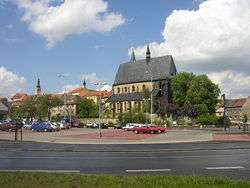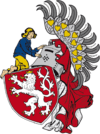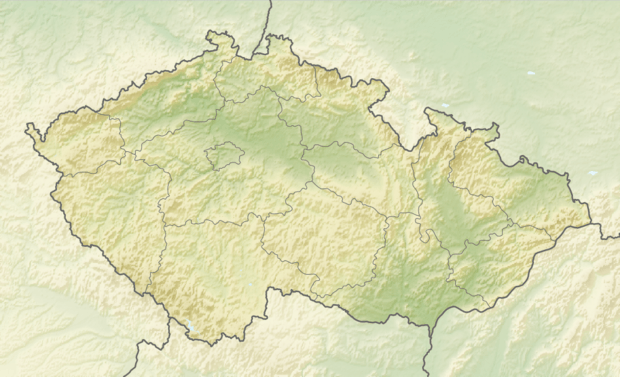Slaný
The Royal town[lower-alpha 1] of Slaný (Czech pronunciation: [ˈslaniː]; German: Schlan) is a town in the Central Bohemian Region of the Czech Republic, located about 25 km northwest of Prague. The town is part of the Prague metropolitan area.
Slaný | |
|---|---|
Town | |
 The centre of Slaný with the St. Gotthard Church from the SE | |
 Flag  Coat of arms | |
 Slaný Location in the Czech Republic | |
| Coordinates: 50°13′50″N 14°4′53″E | |
| Country | Czech Republic |
| Region | Central Bohemian |
| District | Kladno |
| First mentioned | 1239 |
| Government | |
| • Mayor | Martin Hrabánek |
| Area | |
| • Total | 35.11 km2 (13.56 sq mi) |
| Elevation | 234 m (768 ft) |
| Population (2019-01-01[1]) | |
| • Total | 15,834 |
| • Density | 450/km2 (1,200/sq mi) |
| Time zone | UTC+1 (CET) |
| • Summer (DST) | UTC+2 (CEST) |
| Postal code | 250 11 - 274 01 |
| Website | www.meuslany.cz |
The town is situated in the Slaný Plain (the northwestern part of a geomorphologic whole called the Prague Plain). A creek called Červený potok (Red creek) flows through it from the southwest to the northeast. Its dominant feature is Slaný Hill.
History
The Bohemian Chronicle of Václav Hájek records Slaný as having been founded in 750, at the site of a salt spring below Slaný Hill (slaný is Czech for "salty").
The town grew as a result of its location on the trade route between Prague and Saxony. The Benedictines established a hospital here in 1136, together with a church dedicated to St. Gotthard. It was this large presence of the church, and the unconsolidated state of landed property that went with it, that allowed king Wenceslas II to charter Slaný as a town and give his royal assent to its Magdeburg rights only sometime in the decade after 1295. In 1348, an earthquake damaged the now-fortified town; in 1371, a large fire broke out, and the church had to be rebuilt.
Slaný was captured by the Taborites in 1425 during the Hussite Wars, and remained in their hands until 1434. Not only did the Benedictine monks have to leave — this town by the hill was also one of Hussite holy cities, and their preachers expected it to survive the anticipated end of the world. Later, the Hussite king George of Poděbrady gave Slaný many privileges, after the town had supported his election to the throne. The town also participated in the Bohemian Revolt that opened the Thirty Years' War, housing the family of king Frederick I of the Palatinate. After the battle of White Mountain, that meant a defeat for the cause, the town suffered as a result of the ravages of war. Afterwards, the new Catholic possessors of Slaný, the Martinic, erected many a baroque church and edifice that, together with a new monastery, adorn the town to this day.
Since the middle of the 19th century, Czech has been the dominant language there. Industrial development was delayed until around 1860. An important engineering factory was built in 1872 and more followed. A factory producing batteries was founded in 1918. The infrastructure and amenities of a modern town have been gradually added since the second half of the 19th century.
Slaný today
The villages of Dolín, Želevčice, Lotouš, Blahotice, Netovice, Kvíc, Kvíček, Trpoměchy and Otruby are all administrative parts of Slaný.
The town of Slaný is situated at the crossing of the Prague - Louny, Prague - Karlovy Vary roads. The Prague - Most railway also goes through the town.
Important buildings and tourist sights
- the town hall, symbol of the town (house from 1378, rebuilt after 1896 and in 1840) [2]
- The Trinitarian Church, built 1581-1602, a monastery built in 1655-1662[2]
- former college of Piarists (built 1658, rebuilt 1877), today a museum[2]
- St. Gothard's Gothic Church (originally from the 13th century)[2]
- Renaissance houses[2]
- nearby ruins of Gothic Okoř Castle[3]
- outdoor museum of army in the village Smečno (shows pre-World War II fortifications)[3]
- museum of historical cars in the village Hobšovice[3]
- open-air museum about mining in the village Vinařice[3]
Notable people
- Václav Beneš Třebízský (1849–1884), priest and novelist
- František Bílek (1885–1972), founder of Czech modern livestock breeding
- Ladislav Čepelák (1924–2001), painter and graphic artist
- František Duras (1851–1931, photographer, director of the museum of Slaný
- Oskar Fischer (1876-1942), MD, studied dementia
- Josef František Frič (1804–1876), lawyer, promoted Czech language in the legal area
- Josef Holub (1870–1957), painter, born in Slaný
- Eduard Hradec (1918), co-founder of Czech modern urology
- Dominik Kynský (1777–1848), writer and translator
- Josef Lacina (1850–1907), historian, historical writer (pen-name Kolda Malínský), maintained town archive
- Jan Malypetr (1873–1947), politician, prime minister of Czechoslovakia, died there
- František Karel Miltner (1797–1874), archeologist, coin collector, active in politics around 1848
- Václav Nejtek (1899–1958), academic sculptor, several of his statues can be found in the town
- Josef Pacák (1927–2010), professor of organic chemistry at Charles University
- Martin Přibyl, priest, national revivalist, royal archivist in exile in Berlin
- Karel Scheinpflug (1869–1948), writer, entrepreneur
- Olga Scheinpflugová (1902–1968), actress and author, born there
- Václav Smetáček (1906–1986), composer, conductor
- Rudolf Štech (1858–1908), architect, reconstructed town hall
- Václav Štech (1859–1947) writer, dramatist, co-founder of the Museum of Slaný
- Václav Vilém Štech (1885–1974), historian of arts, journalist
- Jan Šultys from Felsdorf (Johann Schulz von Felsdorf), later on mayor of the town of Kutná Hora
- Jiří Tlustý (born 1988), ice hockey player
- Rudolf Urbánek (1877–1962), historian, professor at the University of Brno
- Daniel Vepřek (1600–1657), chronicler of the town, born there
- Karel Alois Vinařický (1803–1869), writer and translator
- Jakub Voráček (born 1989), ice hockey player
- Jan Zach (1914–1986) artist, sculptor, scholar
Twin towns — sister cities
Slaný is twinned with:[4]
References
- The granting of Royal town (Královské město) status signified important privileges during medieval times.
- "Population of municipalities of the Czech republic". Czech Statistical Office. Retrieved 2019-04-30.
- Historical monuments of the town of Slaný
- The environs of the town of Slaný
- "Do Slaného přijeli hosté z partnerských měst" (in Czech). Město Slaný. 2017-10-04. Retrieved 2019-08-24.
Bibliography
- Kubánek, Vladimír (2010). Královské město Slaný na pozadí historie. Brno.
- Dobner, Libor (2016). Slaný - kapitoly z historie královského města. Slaný: Roman Kabátek, Jiří Linke.
- Lacina, Josef (1885). Paměti královského města Slaného, I. Za svobody i v porobě. Slaný.
External links
| Wikimedia Commons has media related to Slaný. |
- A detailed English version of the municipal website
- Other municipal website (in Czech)
- History of the town (in English)
- Museum of Slaný (in Czech)
- Culture life in Slaný (in Czech)
- Slany - travel guide (basic facts, history, sights, day trips)
- Chisholm, Hugh, ed. (1911). . Encyclopædia Britannica. 24 (11th ed.). Cambridge University Press.
- Slaný on the map